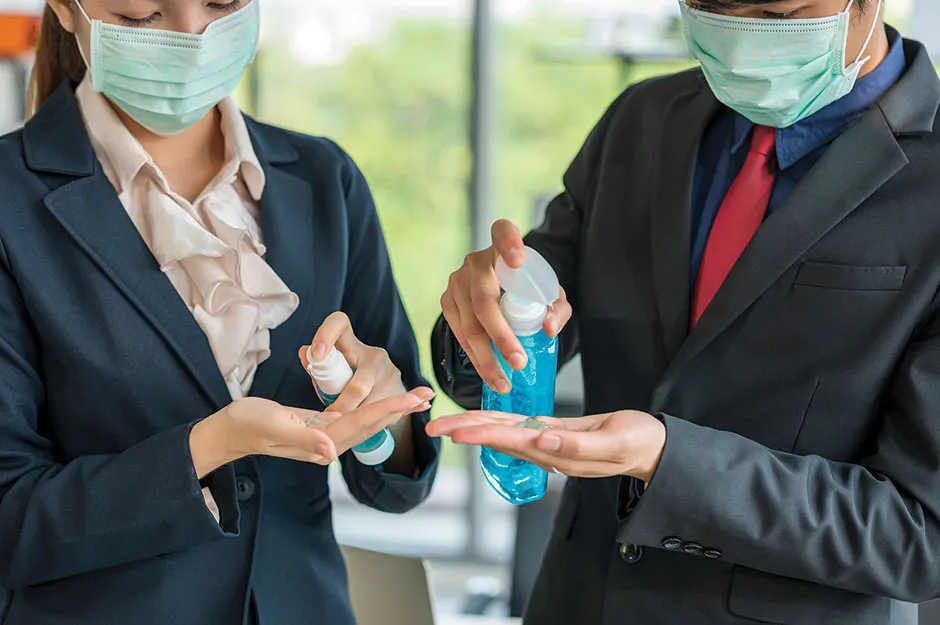Flexible hours and working from home have been on the rise for a number of years, with around 1.7 million people out of the UK’s 32.6 million in employment reporting that they worked mainly from home in 2019, compared to just 884,000 working from home in 2008.
But since the coronavirus pandemic and at the UK government’s request, it’s believed that approximately 44 per cent of working adults – roughly 14.2 million people – have turned their living spaces into a home office.
In 2019, Kelly Reynolds, a professor of public health and environmental science, published a paper looking at the way a virus spreads within the office environment.
Reynolds and her colleagues at the University of Arizona found that simple hygiene measures or interventions, like providing hand sanitiser and disinfection wipes, could result in an 80 per cent reduction in the risk of respiratory and diarrhoeal illnesses.
Throughout the COVID-19 pandemic, Reynolds has been helping businesses with infection control and has been advising public services on how to safely re-open.
Read more about lockdown:
- 5 mental health apps to help you through the coronavirus crisis
- Coronavirus: Is lockdown an opportunity for scientific research?
How does a virus spread around the office?
“If just one person comes to work sick, they can contaminate over 50 per cent of the office surfaces, and their co-workers’ [spaces], in less than four hours,” says Reynolds. “The typical route of transmission is from an infected person’s hands to surfaces that are touched by multiple people.”
This hand-to-surface-to-hand transmission enables a virus to spread quickly in an office setting. That’s why the worst offenders are shared areas, such as the kitchen and toilets, and things touched multiple times a day, like doorknobs and lift buttons, says Reynolds. The most contaminated site? The handle to the refrigerator door.

How can extra hygiene measures help?
Reynolds’s study found that giving each employee hand sanitiser, tissues and surface-disinfecting wipes, along with stocking hand sanitiser in common areas like conference rooms and shared facilities, significantly reduced the risk of virus transmission. Just making these products readily available helps to increase their use, she says.
“Having a hygiene intervention in place is a must to reduce germ transmission in the workplace,” stresses Reynolds.
“While still maintaining social distancing as much as possible, other infection-control methods include installing plexiglass barriers between workers or at popular client interface areas, or requiring masks, to reduce the transmission of aerosols that may transmit coronavirus.”
Read more about coronavirus:
- Mental health: Women and youth hardest hit by lockdown
- BAME women account for more than half of pregnant COVID-19 hospital admissions
What other changes will have to be made?
Businesses will have to go further than just handing out sanitiser. “As workplaces re-open, it is important to do a site-specific assessment of the areas most prone to contamination,” says Reynolds, which means identifying high-touch surfaces and the places where most people congregate throughout the working day.
“Increasing ventilation rates and fresh air exchanges in buildings will help to dilute indoor air contaminants. Remember, too, that if buildings have been shut down for a week or more, it is necessary to flush stagnant water from taps to reduce exposure to deadly bacterial pathogens, such as Legionella, that may have grown over time.”
There’s also a lot to be said for open and upbeat communication on the part of the employer. “Signage with positive messaging about proper hand hygiene and disinfection practices serves to inform employees and customers that your workplace has a culture that values good hygiene and health,” says Reynolds.

She adds: “Administrative controls, such as staggering work schedules or work at home options will also aid in social distancing. Many businesses are doing daily wellness checks – checking temperatures and asking simple health assessment questions such as ‘How are you feeling today?’ and ‘Are you, or is anyone in your family, feeling ill?’
“Having flexible sick policies is important in encouraging sick employees to stay home and not spread their illness to others,” Reynolds explains.
What challenges do we face in designing a more hygienic office?
Reynolds explains that we don’t yet know everything we need to about the novel coronavirus in order to rethink our offices.
“We are learning more about this virus every day. Uncertainties related to how far it can spread or how long it survives on surfaces are still being researched.
"Following best practices in infection prevention, however, can dramatically reduce our risks to SARS-CoV-2 [the virus causing COVID-19] and other pathogens, like influenza and norovirus. Maintaining these safeguards may help to prevent the next outbreak.”
Read more fromReality Check:
- Faster-than-light travel: Is warp drive really possible?
- Why are so many people playing Animal Crossing?
Should we all continue working from home, then?
With more of us setting up working spaces in our own homes, organisations will be considering if returning to the office is the right choice for their employees’ health. But what is the more hygienic option?
“Office buildings are typically worse [for disease transmission] because you have less control there to keep the entire environment clean and sanitised,” says Reynolds, “but we also find that viruses spread efficiently in home environments, where people tend to let their guard down.
"Maintaining proper hand-washing and surface-disinfecting routines at home, and isolating any sick family members to limited areas in your house as much as possible, will help combat this.”
Visit the BBC's Reality Check website at bit.ly/reality_check_ or follow them on Twitter@BBCRealityCheck
